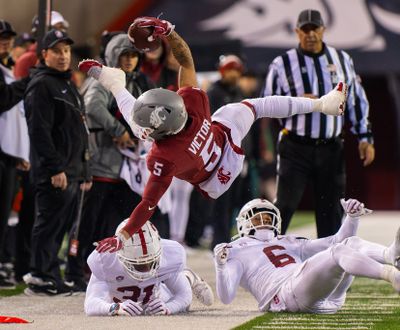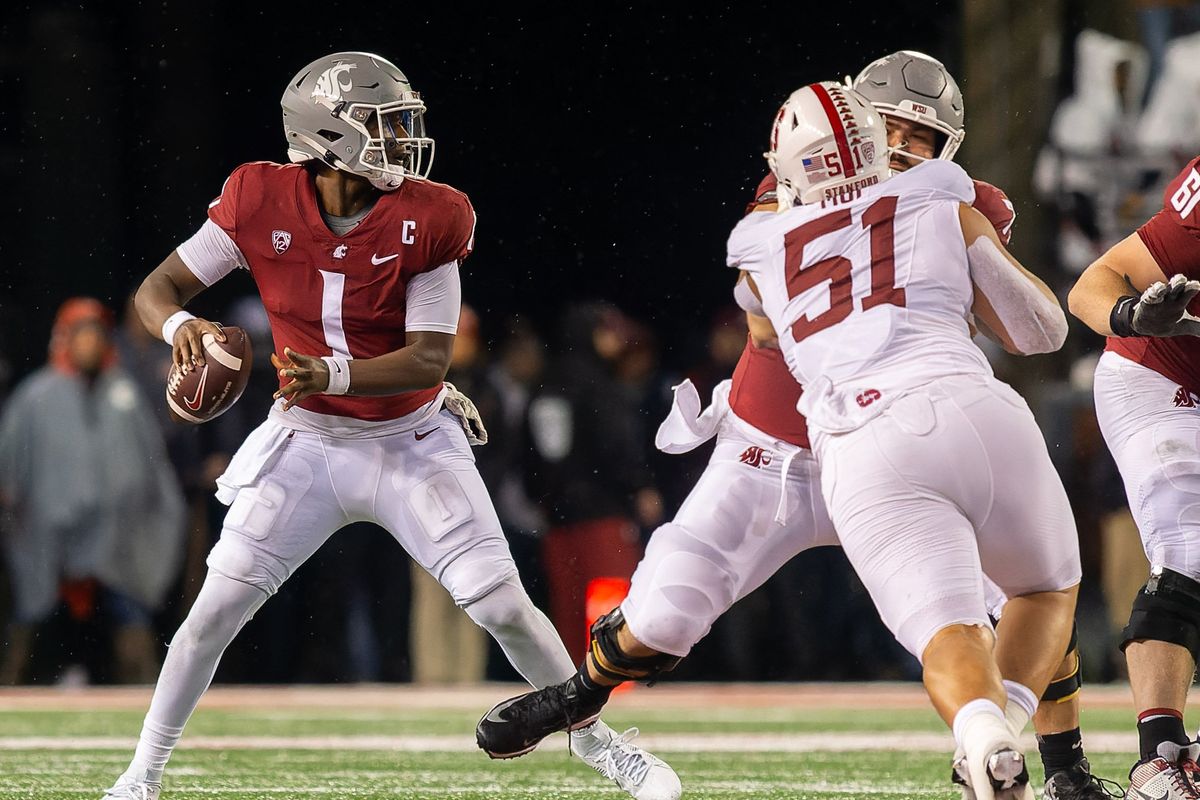Analysis: With loss to Stanford, Washington State has lost the trust of even its most avid supporters

PULLMAN — There comes a point in every team’s undoing when it loses the ability to make supporters believe. Wins turn to losses, the slide hits several games and suddenly, the facade vanishes. Those who held onto hope, even when it made more sense to believe in the Loch Ness Monster, turn their backs.
With this 10-7 loss to Stanford on Saturday evening, Washington State can no longer suspend disbelief. The Cougars are who they are, and now that this losing streak has hit five games, they’ve painted an ugly picture: A toothless group that can’t solve the same issues that have surfaced every week, a inconsistent team that looks like an impostor of the one that won four straight games to open this season.
It’s like a movie that no longer makes sense. You understand it’s impossible, and you try to squint and convince yourself it’s feasible — and then Dom Toretto drives through the nose of an exploding airplane and you realize it’s better to give up the idea that any of it is realistic.
That may be more conceivable than WSU returning to the team that won four straight to kick off the season.
Nothing about Stanford’s approach, from its coverage-heavy defense to its dual-quarterback offense, should have surprised Washington State. Yet the Cougs played like they spun a wheel and picked a random Pac-12 opponent to prepare for. Cameron Ward turned in a couple nice plays, a Houdini-like escape act and a touchdown pass a few plays later, but his accuracy vanished in the second half and his offense went with it.
“We were out of sync. We were out of rhythm,” WSU coach Jake Dickert said. “Balls are on the ground, whether it was drops, whether it was runs, whether it was missed blocks, missed protections. The drop-eight narrative, you keep hearing about that. We need to get over the hump, and to do that we need to be able to run the ball.”
On offense, the culprit behind Washington State’s woes were just that: The lack of any run game, and if that line sounds familiar it’s because the Cougs insist on keeping the problem at the forefront of their team. For nine games now, with the exception of a win over an FCS foe, WSU has not been able to run the ball credibly enough to force defenses to respect that part of its offense.
In fairness to the Cougs, starting running back Nakia Watson was limited by an injury on Saturday — but he hasn’t shown much burst all season either. WSU had to turn to a redshirt freshman, Djouvensky Schlenbaker, against Stanford, and even his 13-carry, 34-yard outing could not cover up the grisly rush total: 4 yards.

The reality is nobody in the Pac-12 respects WSU’s rushing offense, and while the Cougs got a break the last couple weeks with games against teams that don’t like to drop eight in coverage, they have yet to find a solution. The answer is to run the ball. They haven’t been able to, and for as many explanations there might be — the offensive linemen are more comfortable as pass-blockers, the running backs can’t find the holes, you name it — the truth is that proud football programs can’t embarrass themselves like this.
In the box score, Ward will have to accept a combined loss of 36 rushing yards thanks to three sacks he took. The last two were inexplicable. At the beginning of the fourth quarter, right after reserve cornerback Jamorri Colson snagged a momentum-turning interception, WSU took over at the Stanford 35.
After WSU secured one first down, moving to the Cardinal 19 with a chance to take the lead, the hosts next three plays went like this: Schlenbaker 9-yard rush. Ward sacked for a loss of 11. Ward sacked for a loss of 5. That set up a 43-yard field goal attempt for kicker Dean Janikowski, who pulled it wide left.
Somehow, things got even worse for the Cougs’ offense. After Stanford took a 10-7 lead with a field goal, WSU got the ball back inside 6 minutes to play. Washington State went three-and-out: Schlenbaker 5-yard gain. Ward incompletion. Ward incompletion.
There may have been no lower point of the season for Washington State, long the home of a proud offense and an Air Raid system that scares the hell out of opponents. The Cougs haven’t always fielded sturdy defenses, but they’ve reliably built scintillating offenses, throwing it like the world is ending tomorrow and putting up points like their lives depend on it. Whatever has ailed WSU’s teams, seldom has it been offense.
That wasn’t the case in September, and for WSU, that’s a problem as perplexing as it is troublesome. Months ago, the Cougs became college football’s darling by unfurling a colorful offense, a versatile system, a quarterback with the creativity of Patrick Mahomes and an offensive coordinator with the brains to capitalize on it.
Turns out, all it takes to beat that is a simple rush-three, drop-eight scheme. Every team that’s tried it, from UCLA to Arizona to Stanford, has flummoxed WSU. The Cougs have nothing for it, not even a halfway reliable running game.
“I sit up here every week and talk about running the ball. We gotta execute running the ball and keep people off balance,” Dickert said. “There was opportunities out there, and we gotta take the ball down the field, take some of these one-on-one matchups on the edges and take advantage of it. So I think we’ll look at the tape and there’ll be a lot of missed opportunities.”
“I feel like we don’t have a chip on our shoulder right now,” Ward said. “We had a chip on our shoulder those first four games, but we’ll get that back.”
Usually, when fans turn on the TV to watch WSU games, they know to expect something fun on offense. What did they see on Saturday — on that three-and-out?
They saw a quarterback who looked indecisive, receivers who couldn’t hang on to the ball, ballcarriers who couldn’t find space. They saw an offensive line that couldn’t pass-protect, a front five that forced its quarterback to scramble on dozens of dropbacks, forcing him to make his best plays with his mind racing and his legs playing Twister.
All of which gives Washington State three tries to earn two wins and return to bowl eligibility: At Cal, home against Colorado, at Washington. Remove the possibility of a miracle Apple Cup win and WSU must win these next two games to get to six — and even if they do, would the Cougs feel good about a six-win season?
It matters to the Cougs themselves, though, and that’s what matters now. There may not be much WSU can do about getting left behind by the machine of conference realignment, its outlook looking bleaker by the week, but the Cougs can salvage what’s left of this season with wins in these next two games.
Just don’t expect them to be favored. That’s what happens when you lose the trust of your most avid fans.